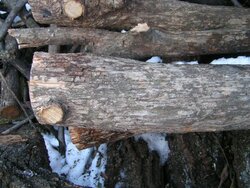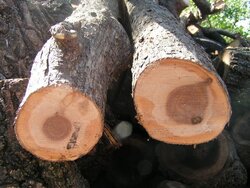Usually my wood supply is a cocktail of various woods. I move it all into the garage in october and it's usually stacked in no particular order.
This year - I've got maple, black locust, cherry, and some oak.
Mostly I've been burning the black locust. With the blizzard and winds that went thru - it was brutal cold. I dug around and pulled some oak out of the stacks. The difference in heat output is amazing. Well seasoned oak REALLY puts out the heat. The black locust, cherry, and maple can't hold a candle to it. Makes me wish I had more of it. I manage to get some every year, but it's tough to scrounge up.
I usually try to manage my wood. Meaning - if I know it's gonna be mild, I'll fill the box by the stove with maple or some poplar. Get rid of the lower BTU wood on an easy day. If it's gonna be cold, I fill the box with locust and cherry. I'm gonna conserve the oak for the Brutal days when I can get the most of it.
Just an observation about burning OAK. I love the stuff and wish I had a boat load of it. I've never burned Osage - maybe I'll get lucky and score some of that too.
So - what wood are you burning this season that's really putting out the most heat for you?
This year - I've got maple, black locust, cherry, and some oak.
Mostly I've been burning the black locust. With the blizzard and winds that went thru - it was brutal cold. I dug around and pulled some oak out of the stacks. The difference in heat output is amazing. Well seasoned oak REALLY puts out the heat. The black locust, cherry, and maple can't hold a candle to it. Makes me wish I had more of it. I manage to get some every year, but it's tough to scrounge up.
I usually try to manage my wood. Meaning - if I know it's gonna be mild, I'll fill the box by the stove with maple or some poplar. Get rid of the lower BTU wood on an easy day. If it's gonna be cold, I fill the box with locust and cherry. I'm gonna conserve the oak for the Brutal days when I can get the most of it.
Just an observation about burning OAK. I love the stuff and wish I had a boat load of it. I've never burned Osage - maybe I'll get lucky and score some of that too.
So - what wood are you burning this season that's really putting out the most heat for you?



